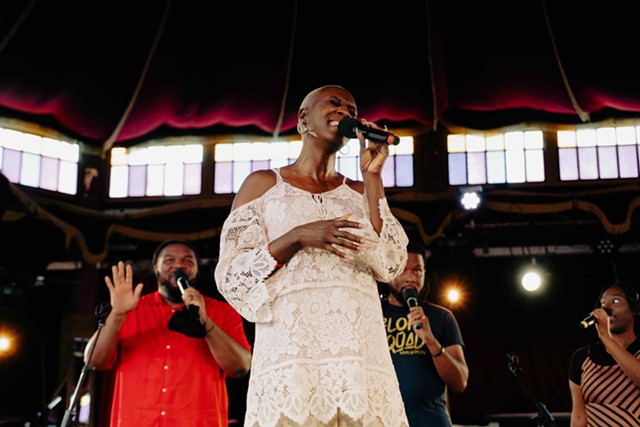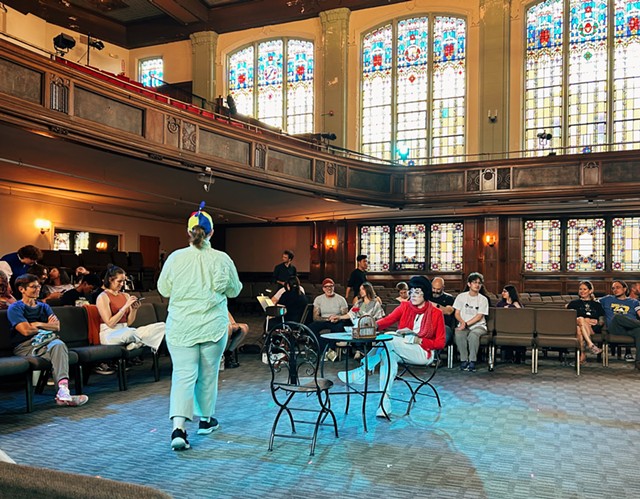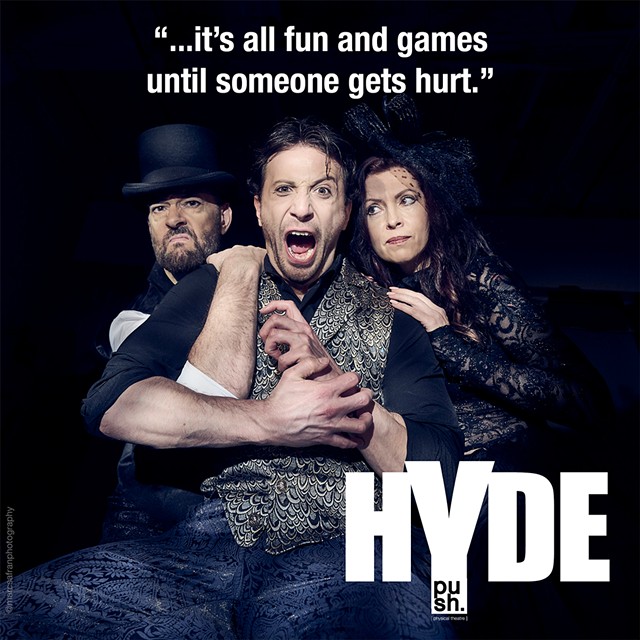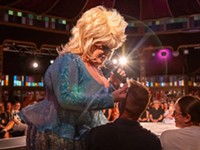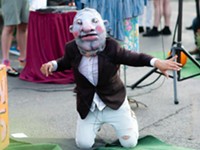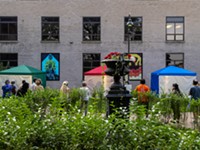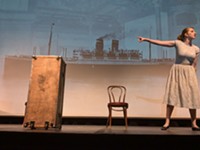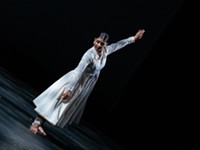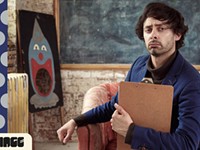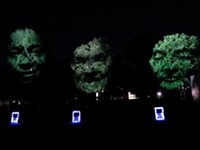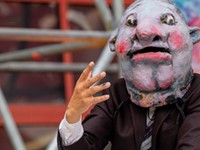[
{
"name": "500x250 Ad",
"insertPoint": "5",
"component": "15667920",
"parentWrapperClass": "",
"requiredCountToDisplay": "1"
}
]
Thank you five
“Diary of a Techie” | MuCCC | Sept. 17 | $12 | Ages 13+
Artists travel from all over the country and world to perform in Fringe, but the festival also gives local groups the chance to play around. Out of Pocket, Inc’s “Diary of a Techie” written and directed by the theater troupe’s co-founder Stephanie Roosa is the ultimate “insider baseball” show for local theater makers and goers.
“Techie” is used as an umbrella term for anyone involved in the design or management of costumes, sound, lights, props and general maintenance of a theatrical production: “the unseen gods that make the actors shine.” Seven Rochester techies played themselves in a 45-minute presentation of monologues and short scenes that was part informational primer on tech theater, part playful airing of grievances.
The anecdotes they share, such as giving a puppet a quick change or ad libbing as a phone operator to save actors who had gone off-book, sounded too specific to be made up. Based on the audience’s delighted reactions, many in the crowd recognized (and were probably part of) the productions being referenced.
These techies were clearly having a great time being onstage presenting material they know well. Appropriately, the tech elements ran smoothly, with comical uses of lighting to convey its importance and vibrant props including a puppet, a chicken dinner, and many colorful scarves.
The takeaway of the show is how hardworking and important techies are to any production. The appreciative audience knew this already, but they were a choir eager for the preaching. —KATHERINE VARGA
Short play's the thing
“All in the Timing” | Sept. 19 | Temple Theater | $15 | Ages 13+
From monkeys to pockets of bad luck, “All in the Timing” takes audiences to different worlds in six short comedies. Sunday Stages Theatre Company stages David Ives’s short plays with an entirely queer femme cast, likely a first for this collection.
Five actors, each tasked with playing three or four characters, capably enacted Ives’s deceptively difficult pieces. The collection’s standout, “Philip Glass Buys a Loaf of Bread,” incorporated all five performers into an energetic, musical six minutes. The tight synchronicity of the cast shone during this scene, bringing the title to life. Performer Trish Annese was a distinct highlight of the evening. Whether portraying an overconfident man or a monkey tasked with writing “Hamlet,” Annese’s presence filled the Temple Theater every time she took the stage.
Director Stevie Burggraaf’s staging placed the audience within the action, including a splash zone, a word search puzzle and audience members writing secrets on pieces of paper, which were then read aloud during a scene transition.
While these additions were charming, they may have ultimately distracted from the action, with some audience members completing their word search instead of watching the many deaths of Leon Trotsky. The in-the-round staging did not help with this problem, with the space swallowing lines of dialogue.
Ives’s short plays require attention to detail, especially with made-up languages added to the mix, as in “Universal Language.” Depending on the seat audience members choose, it was easy lose track of the action, especially while holding props or being offered a gluten-free cracker. Despite occasional distractions, “All in the Timing” is an entertaining, interactive 90-minute romp into the work of a short plays master. —ALLY WATKINSON
Make 'em laugh
“How to Look at Art When You Don’t Get It (It’s OK to Laugh)” | SOTA: Club SOTA | Sept. 20 | $10 | 16+
Modern art can be difficult — there’s so much to discuss and sometimes, nowhere to start. That’s where Amy Boyle “Bonk” Johnston comes in, as she brings her show “How to Look at Art When You Don’t Get It (It's Ok to Laugh)” to the Rochester Fringe Festival.
The 50-minute show opens the audience to Johnston's world as she tells her stories of art school and becoming an artist. Johnston makes it clear that the stories are 100% her experience and becomes vulnerable about why she shouldn’t be an artist, tempering with humor. She’s witty and quick, and the jokes are sometimes easy to miss if you aren’t fully paying attention, and cooked up for an adult audience (sorry, kids under 16).
Along with the show’s storytelling style, Johnston provides the audience with visuals of her work. As part of the set, Club SOTA at School of Arts is filled with black and white framed photographs on the walls. Some of the pieces included are photographs Johnston made while working on her MFA at Visual Studies Workshop.
Toward the end of the show, Johnston gives insight into a different way of looking at modern art, beginning with a little history of modern art, especially when it comes to the Museum of Modern Art. She ends the show by sharing with people how to look at modern art differently — something best said by Johnston herself. —SARA ATENCIO-GONZALES
No place to hyde
“PUSH Physical Theatre: Hyde” | School of the Arts: Allen Main Stage Theatre | Sept. 20, 21 | $18 | Ages 13+
Impressive physical acts. Audience interaction. Frequent cussing. An emotional roller coaster in under an hour. A shoehorned-in trolley problem-esque moral quandary to create the illusion of depth. “Hyde,” the latest offering from local movement group PUSH Physical Theatre, hits Fringe bingo.
The show introduces three narrative strands. First up is a humorous framing device: the host Abel Hyde (played by the darkly charismatic Ashley Jones) is having trouble getting the Fringe show “Hyde” to go on. He can’t get through the introductory remarks without a blackout, a pre-recorded interruption and a phone call from an important guest who’s running late. To kill time (pun intended), he plays his own version of “Wink, Murder” and asks the whole audience to play dead.
With an abrupt change in lighting, this irreverent meta-device cuts to the tragic second strand, a scene between a mass shooter and his mother in an interrogation room while a police officer stands guard.
The third and most compelling strand loosely adapts “Jekyll and Hyde” using PUSH’s signature physical storytelling. Darren Stevenson as Jekyll enters on a stormy night with a top hat and Victorian-era lantern while Heather Stevenson rounds out the cast as Jekyll’s love interest / victim (as well as the mother in the earlier scene). Jekyll’s lab is brought to life through mesmerizing movement: impressive body leans and miming of potion mixing. Jekyll and Hyde share a stunning and visceral duet, where the two pull apart in symmetrical shapes and tumble together in cartwheels under dark, red lighting and ominous music.
The three strands clearly want to come together to say something profound about the humanity of killers. Or maybe about the unconditional love of mothers. Or about how nobody is as moral as they think. Or police brutality? Or the nature of art? The show is strongest when it stops trying to say something and lets the performers’ entrancing movement speak for itself. —KATHERINE VARGA
“Diary of a Techie” | MuCCC | Sept. 17 | $12 | Ages 13+
Artists travel from all over the country and world to perform in Fringe, but the festival also gives local groups the chance to play around. Out of Pocket, Inc’s “Diary of a Techie” written and directed by the theater troupe’s co-founder Stephanie Roosa is the ultimate “insider baseball” show for local theater makers and goers.
“Techie” is used as an umbrella term for anyone involved in the design or management of costumes, sound, lights, props and general maintenance of a theatrical production: “the unseen gods that make the actors shine.” Seven Rochester techies played themselves in a 45-minute presentation of monologues and short scenes that was part informational primer on tech theater, part playful airing of grievances.
The anecdotes they share, such as giving a puppet a quick change or ad libbing as a phone operator to save actors who had gone off-book, sounded too specific to be made up. Based on the audience’s delighted reactions, many in the crowd recognized (and were probably part of) the productions being referenced.
These techies were clearly having a great time being onstage presenting material they know well. Appropriately, the tech elements ran smoothly, with comical uses of lighting to convey its importance and vibrant props including a puppet, a chicken dinner, and many colorful scarves.
The takeaway of the show is how hardworking and important techies are to any production. The appreciative audience knew this already, but they were a choir eager for the preaching. —KATHERINE VARGA
Short play's the thing
“All in the Timing” | Sept. 19 | Temple Theater | $15 | Ages 13+
From monkeys to pockets of bad luck, “All in the Timing” takes audiences to different worlds in six short comedies. Sunday Stages Theatre Company stages David Ives’s short plays with an entirely queer femme cast, likely a first for this collection.
Five actors, each tasked with playing three or four characters, capably enacted Ives’s deceptively difficult pieces. The collection’s standout, “Philip Glass Buys a Loaf of Bread,” incorporated all five performers into an energetic, musical six minutes. The tight synchronicity of the cast shone during this scene, bringing the title to life. Performer Trish Annese was a distinct highlight of the evening. Whether portraying an overconfident man or a monkey tasked with writing “Hamlet,” Annese’s presence filled the Temple Theater every time she took the stage.
Director Stevie Burggraaf’s staging placed the audience within the action, including a splash zone, a word search puzzle and audience members writing secrets on pieces of paper, which were then read aloud during a scene transition.
While these additions were charming, they may have ultimately distracted from the action, with some audience members completing their word search instead of watching the many deaths of Leon Trotsky. The in-the-round staging did not help with this problem, with the space swallowing lines of dialogue.
Ives’s short plays require attention to detail, especially with made-up languages added to the mix, as in “Universal Language.” Depending on the seat audience members choose, it was easy lose track of the action, especially while holding props or being offered a gluten-free cracker. Despite occasional distractions, “All in the Timing” is an entertaining, interactive 90-minute romp into the work of a short plays master. —ALLY WATKINSON
Make 'em laugh
“How to Look at Art When You Don’t Get It (It’s OK to Laugh)” | SOTA: Club SOTA | Sept. 20 | $10 | 16+
Modern art can be difficult — there’s so much to discuss and sometimes, nowhere to start. That’s where Amy Boyle “Bonk” Johnston comes in, as she brings her show “How to Look at Art When You Don’t Get It (It's Ok to Laugh)” to the Rochester Fringe Festival.
The 50-minute show opens the audience to Johnston's world as she tells her stories of art school and becoming an artist. Johnston makes it clear that the stories are 100% her experience and becomes vulnerable about why she shouldn’t be an artist, tempering with humor. She’s witty and quick, and the jokes are sometimes easy to miss if you aren’t fully paying attention, and cooked up for an adult audience (sorry, kids under 16).
Along with the show’s storytelling style, Johnston provides the audience with visuals of her work. As part of the set, Club SOTA at School of Arts is filled with black and white framed photographs on the walls. Some of the pieces included are photographs Johnston made while working on her MFA at Visual Studies Workshop.
Toward the end of the show, Johnston gives insight into a different way of looking at modern art, beginning with a little history of modern art, especially when it comes to the Museum of Modern Art. She ends the show by sharing with people how to look at modern art differently — something best said by Johnston herself. —SARA ATENCIO-GONZALES
No place to hyde
“PUSH Physical Theatre: Hyde” | School of the Arts: Allen Main Stage Theatre | Sept. 20, 21 | $18 | Ages 13+
Impressive physical acts. Audience interaction. Frequent cussing. An emotional roller coaster in under an hour. A shoehorned-in trolley problem-esque moral quandary to create the illusion of depth. “Hyde,” the latest offering from local movement group PUSH Physical Theatre, hits Fringe bingo.
The show introduces three narrative strands. First up is a humorous framing device: the host Abel Hyde (played by the darkly charismatic Ashley Jones) is having trouble getting the Fringe show “Hyde” to go on. He can’t get through the introductory remarks without a blackout, a pre-recorded interruption and a phone call from an important guest who’s running late. To kill time (pun intended), he plays his own version of “Wink, Murder” and asks the whole audience to play dead.
With an abrupt change in lighting, this irreverent meta-device cuts to the tragic second strand, a scene between a mass shooter and his mother in an interrogation room while a police officer stands guard.
The third and most compelling strand loosely adapts “Jekyll and Hyde” using PUSH’s signature physical storytelling. Darren Stevenson as Jekyll enters on a stormy night with a top hat and Victorian-era lantern while Heather Stevenson rounds out the cast as Jekyll’s love interest / victim (as well as the mother in the earlier scene). Jekyll’s lab is brought to life through mesmerizing movement: impressive body leans and miming of potion mixing. Jekyll and Hyde share a stunning and visceral duet, where the two pull apart in symmetrical shapes and tumble together in cartwheels under dark, red lighting and ominous music.
The three strands clearly want to come together to say something profound about the humanity of killers. Or maybe about the unconditional love of mothers. Or about how nobody is as moral as they think. Or police brutality? Or the nature of art? The show is strongest when it stops trying to say something and lets the performers’ entrancing movement speak for itself. —KATHERINE VARGA
